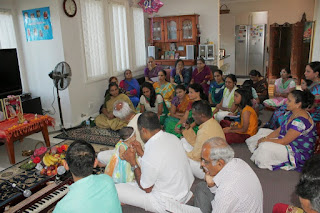Nara,
Oshina Hakkai,& Hakone
On 12th morning
we vacated the hotel and moved with our hand luggage to Nara. Our main luggage was transported separately
to our next hotel of stay, Jirigonno Fuji No Yakata. In Nara our first place of visit was Todaji
Temple, located in the Nara Park. It has one of the largest bronze statues of
Buddha which is 15 metres tall and is flanked by two Bodhisattvas. A popular
attraction is a pillair which has a hole in its base. It is believed that those who can squeeze
through the hole from one side to the other will get enlightenment, if not in
this birth at least in the next birth. Deer roam freely in Nara park and it is
said there are around 1200 of them in the park.
Deer -crackers are sold in the park and visitors feed them these
crackers. The deer freely surround the visitors seeking cookies.
From Nara Park we made our
way to Kyoto where we had lunch and moved on to the station to board the bullet
train, Kodama super express to Shin Fuji.
Though called a super express it halted in almost all stations on the
way. We could feel the speed only when we stood in the passage between
compartments. Our night stay was at
Jirgonna Fuji No Yakata, a traditional Japanese style hotel which was set on the foothills of Mount Fuji and
surrounded by woodland. We wore Yakata,
a sort of dressing gown, for dinner which was on buffet style. We had carried yoghurt
with us and so taking more than a bowl of rice, we managed our dinner without difficulty. It has an indoor hot spring bathhouse which
you can make use of only in the buff.
So I alone made use of it after dinner before going to bed. Photos of
Nara can be seen in Flickr album ‘Nara’ @ https://www.flickr.com/photos/sam-sekar/albums/72157666328716814
Next morning after breakfast we left for Oshino Hakkai, a small village
which has eight ponds which are fed by melting snow filtering down the slopes
of Mt. Fuji through the porous layers of lava. So waters in the lakes are clear
spring waters and are known as Springs of Mt. Fuji. Next to one pond, we can
drink the cool water straight from the source.
After drinking from the source we also filled our bottle with the cool spring
water. There are large fishes in this pond swimming merrily. Also we could see houses with beautiful private
gardens. There are many small shops and
vendors around the pond selling local foodstuff. In contrast to the first day, we had clear
bright sky on all other days. This made possible a beautiful view of Mt. Fuji,
bright and without clouds, which we were told is not a regular phenomenon.
From the village of Oshino Hakkai we went to the Peace Park, in Gotemba. It commands a good view of
Mt. Fuji and houses a stupa in white chalk.
This stupa was a donation from India by the then Prime Minister, Pandit
Jawaharlal Nehru. Along with the stupa, the ashes of Buddha was also donated by
India, which is kept in the Stupa. In the Stupa there are four golden images of
Buddha, one on each of its four sides.
In front of the stupa the guardian dogs representing various Asian Buddhist
countries are there. Foremost of them near
the Stupa is the one representing India. Although referred to as dogs they more
resemble lions. On the opposite side is
a row of Kirins. Kirin is a mythological sacred animal with the face of a
dragon, the tail of a bull and hooves of a horse. There is also a Japanese
garden and a temple and images of Deity of Mercy. The park has numerous cherry trees and in the
cherry blossom season, the beautiful cherry blossoms in the backdrop of Mt.
Fuji are a grand sight to watch, it was said.
Our next halt was at Hakone Shrine. Shinto places of worship are called shrines and are
usually found in beautiful natural settings. Shintoism is the
oldest and original religion of Japan. The followers of Shintoism believe that spiritual
powers exist in the natural world. They believe that "spirits" called
kami live in natural places such as in plants, stones, mountains,
rivers etc. Shinto shrines are marked by
a special archway called a Torii. This
archway is believed to separate the sacred world of the shrine from the world
outside. Purity is
important to Shinto followers and therefore they rinse their mouths and wash
their hands before entering the prayer hall. Here the shrine is up a small
wooded hill with a flight of
steps to the main shrine and a huge Torii Gate before the start of steps. In
shrine there are no images and it is the prayer hall where they pray to
Kami. Before the shrine there is a
fountain whose water is used for cleaning the hands and rinsing the mouth
before entering the shrine for prayer. Buddhism came to Japan from India much later
and the place of worship of Buddhist
religion is called the Temple and it houses the image of Buddha and
Bodhisatvas. Shintoism and Buddhism are
two leading religions of Japan, peacefully co-existing.
From Hakone shrine we went to the shores of Lake Ashi for a cruise in
the lake in a pirate ship. The lake was formed after the last eruption of Mount
Hakone. This was a scenic 30 minute
cruise from one end of the lake to the other.
After disembarking at the other end, we left for Tokyo. Photos of Oshino
Hakkai and Hakone can be seen in Flickr album ‘OshinoHakkai & Hakone’ @ https://www.flickr.com/photos/sam-sekar/albums/72157666328716814

